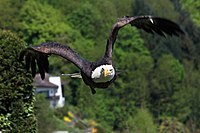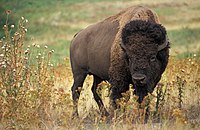MarshalN20 (talk | contribs) |
MarshalN20 (talk | contribs) |
||
| Line 142: | Line 142: | ||
=== WW I, Roaring 20s, Depression === |
=== WW I, Roaring 20s, Depression === |
||
[[File: |
[[File:Christy's Halloween.jpg|left|thumb|Largest ancestry groups by county, 2000]] |
||
{{clear}} |
{{clear}} |
||
Revision as of 14:10, 4 July 2014
United States of America | |
|---|---|
| Motto: | |
| Anthem: "The Star-Spangled Banner" | |
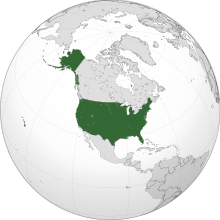 | |
| Capital | Washington, D.C. |
| Largest city | New York City |
| Official languages | None at federal level[a] |
| National language | American English[b] |
| Demonym(s) | American |
| Government | Federal presidential constitutional republic |
| Barack Obama (D) | |
| Joe Biden (D) | |
| John Boehner (R) | |
| John Roberts | |
| Legislature | Congress |
| Senate | |
| House of Representatives | |
| Independence from Great Britain | |
• Declared | July 4, 1776 |
| September 3, 1783 | |
| June 21, 1788 | |
| Area | |
• Total | 9,826,675 km2 (3,794,100 sq mi)[4][c] (3rd/4th) |
• Water (%) | 6.76 |
| Population | |
• 2013 estimate | 336,585,000[5] (3rd) |
• Density | 34.2/km2 (88.6/sq mi) (179th) |
| GDP (PPP) | 2013 estimate |
• Total | $16.724 trillion[6] (1st) |
• Per capita | $52,839[6] (6th) |
| GDP (nominal) | 2013 estimate |
• Total | $16.724 trillion[6] (1st) |
• Per capita | $52,839[6] (9th) |
| Gini (2011) | 47.7[7] high (39th (2009)) |
| HDI (2013) | very high (3rd) |
| Currency | [[]] ($) (USD) |
| Time zone | UTC−5 to −10 |
• Summer (DST) | UTC−4 to −10[e] |
| Driving side | right[g] |
| Calling code | +1 |
| ISO 3166 code | US |
| Internet TLD | .us .gov .mil .edu |
| |
The United States, officially the United States of America, is a country in northern North America. Its contiguous territory is bordered in the north by Canada, in the south by Mexico, in the west by the Pacific Ocean, and in the east by the Atlantic Ocean. Its non-contiguous territory extends the country's borders worldwide. At 4 square miles (9.83 square kilometres) in total, the United States is the fourth-largest country by total area.
The U.S. mainland was originally inhabited by various Native American civilizations. Europeans colonized the region beginning in the 16th century. After obtaining independence from Great Britain in 1783, the United States developed into a major regional power in the Western Hemisphere, and underwent territorial expansion under the doctrine of manifest destiny. The territorial integrity of the state was consolidated following a civil war, and the U.S. thereafter entered a Gilded Age of increasing industrialization, immigration, and social reform. In the twentieth century, the country's leading role in two world wars confirmed its status as a global superpower and a permanent member of the United Nations Security Council. After the end of a decades-long Cold War with the Soviet Union, the United States became the world's foremost economic, military, and technological power.
The United States is a federal republic divided into 50 states, 16 territories, a federal district, and various overseas extraterritorial jurisdictions. Its diverse geography include the vast Interior Plains, arctic Alaska, tropical Hawaii, the valleys of its Appalachian highlands, and the arid deserts of its Southwest. It is a developed country with a very high Human Development Index. Its national economy is the world's largest, and it is fueled by an abundance of natural resources, a well-developed infrastructure, and a large manufacturing sector.
The U.S. population, estimated at 316 million, is the third largest in the world. Americans are multiethnic and multicultural, the product of large-scale immigration. The main spoken language is English, and a significant number of the nation's inhabitants also speak Spanish. At the forefront of its national identity, the U.S. has traditionally upheld the ideals of freedom, democracy, and opportunity.
Etymology
In 1507, the German cartographer Martin Waldseemüller produced a world map on which he named the lands of the Western Hemisphere "America" after the Italian explorer and cartographer Amerigo Vespucci.[11]
The first documentary evidence of the phrase "United States of America" is from a letter dated January 2, 1776, written by Stephen Moylan, Esq., George Washingon's aide-de-camp and Muster-Master General of the Continental Army. Addressed to Lt. Col. Joseph Reed, Moylan expressed his wish to carry the "full and ample powers of the United States of America" to Spain to assist in the revolutionary war effort.[12]
The first publicly published evidence of the phrase "United States of America" was in an anonymously written essay in The Virginia Gazette newspaper in Williamsburg, Virginia, on April 6, 1776.[13][14] In June 1776, Thomas Jefferson included the phrase "UNITED STATES OF AMERICA" in all capitalized letters in the headline of his "original Rough draught" of the Declaration of Independence.[15][16] In the final Fourth of July version of the Declaration, the pertinent section of the title was changed to read, "The unanimous Declaration of the thirteen united States of America".[17]
In 1777 the Articles of Confederation announced, "The Stile of this Confederacy shall be 'The United States of America'".[18]
The short form "United States" is also standard. Other common forms include the "U.S.", the "USA", and "America". Colloquial names include the "U.S. of A." and, internationally, the "States". "Columbia", a name popular in poetry and songs of the late 1700s,[19] derives its origin from Christopher Columbus; it appears in the name "District of Columbia".
The standard way to refer to a citizen of the United States is as an "American". "United States", "American" and "U.S." are used to refer to the country adjectivally ("American values", "U.S. forces"). "American" is rarely used in English to refer to subjects not connected with the United States.[20]
The phrase "United States" was originally treated as plural, a description of a collection of independent states—e.g., "the United States are"—including in the Thirteenth Amendment to the United States Constitution, ratified in 1865. It became common to treat it as singular, a single unit—e.g., "the United States is"—after the end of the Civil War. The singular form is now standard; the plural form is retained in the idiom "these United States".[21] The difference has been described as more significant than one of usage, but reflecting the difference between a collection of states and a unit.[22]
In non-English languages, the name is frequently translated as the translation of either the "United States" or "United States of America", and colloquially as "America". In addition, an initialism is sometimes used.[23]
History
Prehistory
Native American and European contact
13 Colonies & French/Indian War
Independence & Constitution
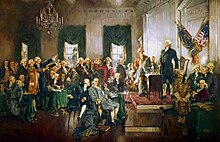
Expansion & Monroe Doctrine
Civil War & Reconstruction

Gilded Age & Spanish-American War
WW I, Roaring 20s, Depression
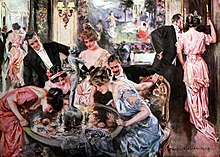
New Deal, World Wars
Cold War Era & Space Race
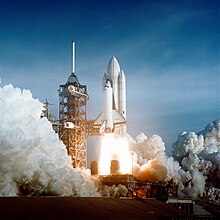
Modern Era
Government

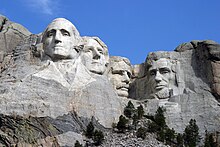
States and territories

Geography
Biodiversity
Economy
Science and technology
Demographics

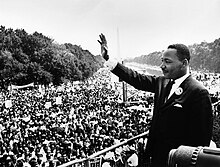
Culture
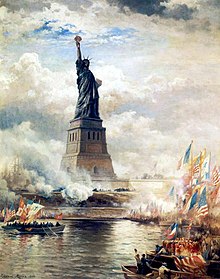
See also
- Index of United States-related articles
- Outline of the United States
- List of United States cities by population
- List of metropolitan areas of the United States
- List of official United States national symbols
- Template:Wikipedia books link
References
- ^ 36 U.S.C. § 302 National motto
- ^ Simonson, 2010
- ^ Dept. of Treasury, 2011
- ^ Cite error: The named reference
WFwas invoked but never defined (see the help page). - ^ "U.S. POPClock Projection". U.S. Census Bureau. (figure updated automatically).
- ^ a b c d "World Economic Outlook Database: United States". International Monetary Fund. 2013. Retrieved November 5, 2013.
{{cite web}}: Unknown parameter|month=ignored (help) - ^ "Income, Poverty and Health Insurance Coverage in the United States: 2011". Newsroom. United States Census Bureau. September 12, 2012. Retrieved January 23, 2013.
- ^ "Human Development Report 2013" (PDF). United Nations Development Programme. March 14, 2013. Retrieved March 14, 2013.
- ^ Cite error: The named reference
ILWwas invoked but never defined (see the help page). - ^ "Ecological Footprint Atlas 2010" (PDF). Global Footprint Network. Retrieved July 11, 2011.
- ^ "Cartographer Put 'America' on the Map 500 years Ago". USA Today. Washington, D.C. Associated Press. April 24, 2007. Retrieved November 30, 2008.
- ^ DeLear, Byron (July 4, 2013) Who coined 'United States of America'? Mystery might have intriguing answer. "Historians have long tried to pinpoint exactly when the name 'United States of America' was first used and by whom. A new find suggests the man might have been George Washington himself." Christian Science Monitor (Boston, MA).
- ^ "To the inhabitants of Virginia," by A PLANTER. Dixon and Hunter's Virginia Gazette #1287 – April 6, 1776, Williamsburg, Virginia. Letter is also included in Peter Force's American Archives Vol. 5
- ^ Carter, Rusty (August 18, 2012). "You read it here first"[dead link]. Virginia Gazette. "He did a search of the archives and found the letter on the front page of the April 6, 1776, edition, published by Hunter & Dixon."
- ^ DeLear, Byron (August 16, 2012). "Who coined the name 'United States of America'? Mystery gets new twist." Christian Science Monitor (Boston, MA).
- ^ Jefferson's "original Rough draught" of the Declaration of Independence
- ^ "The Charters of Freedom". National Archives. Retrieved June 20, 2007.
- ^ Mary Mostert (2005). The Threat of Anarchy Leads to the Constitution of the United States. CTR Publishing, Inc. p. 18. ISBN 9780975385142.
- ^ "Get to Know D.C." Historical Society of Washington, D.C. Retrieved July 11, 2011.
- ^ Wilson, Kenneth G. (1993). The Columbia Guide to Standard American English. New York: Columbia University Press, pp. 27–28. ISBN 0-231-06989-8.
- ^ Zimmer, Benjamin (November 24, 2005). "Life in These, Uh, This United States". University of Pennsylvania—Language Log. Retrieved January 5, 2013.
- ^ G. H. Emerson, The Universalist Quarterly and General Review, Vol. 28 (Jan. 1891), p. 49, quoted in Zimmer paper above.
- ^ For example, the U.S. embassy in Spain calls itself the embassy of the "Estados Unidos", literally the words "states" and "united", and also uses the initials "EE.UU.", the doubled letters implying plural use in Spanish [1] Elsewhere on the site "Estados Unidos de América" is used [2]
- ^ "Statue of Liberty". World Heritage. UNESCO. Retrieved October 20, 2011.





